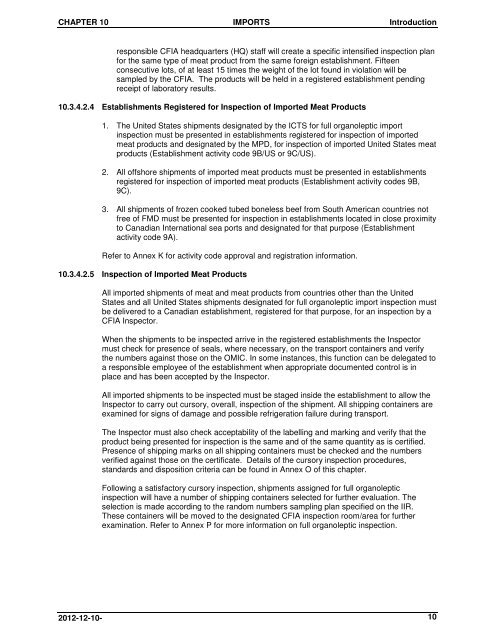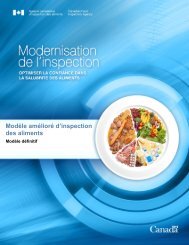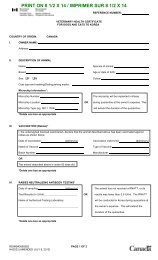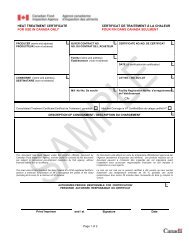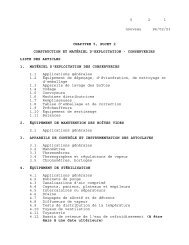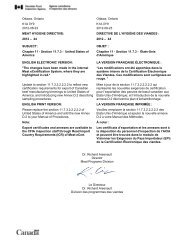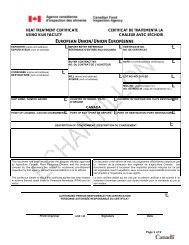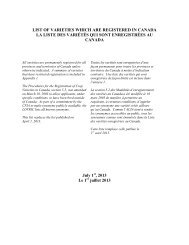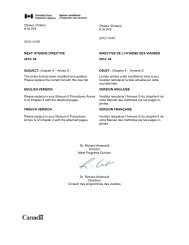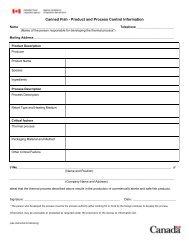PDF (342 kb ) - Agence canadienne d'inspection des aliments
PDF (342 kb ) - Agence canadienne d'inspection des aliments
PDF (342 kb ) - Agence canadienne d'inspection des aliments
You also want an ePaper? Increase the reach of your titles
YUMPU automatically turns print PDFs into web optimized ePapers that Google loves.
CHAPTER 10 IMPORTS Introductionresponsible CFIA headquarters (HQ) staff will create a specific intensified inspection planfor the same type of meat product from the same foreign establishment. Fifteenconsecutive lots, of at least 15 times the weight of the lot found in violation will besampled by the CFIA. The products will be held in a registered establishment pendingreceipt of laboratory results.10.3.4.2.4 Establishments Registered for Inspection of Imported Meat Products1. The United States shipments <strong>des</strong>ignated by the ICTS for full organoleptic importinspection must be presented in establishments registered for inspection of importedmeat products and <strong>des</strong>ignated by the MPD, for inspection of imported United States meatproducts (Establishment activity code 9B/US or 9C/US).2. All offshore shipments of imported meat products must be presented in establishmentsregistered for inspection of imported meat products (Establishment activity co<strong>des</strong> 9B,9C).3. All shipments of frozen cooked tubed boneless beef from South American countries notfree of FMD must be presented for inspection in establishments located in close proximityto Canadian International sea ports and <strong>des</strong>ignated for that purpose (Establishmentactivity code 9A).Refer to Annex K for activity code approval and registration information.10.3.4.2.5 Inspection of Imported Meat ProductsAll imported shipments of meat and meat products from countries other than the UnitedStates and all United States shipments <strong>des</strong>ignated for full organoleptic import inspection mustbe delivered to a Canadian establishment, registered for that purpose, for an inspection by aCFIA Inspector.When the shipments to be inspected arrive in the registered establishments the Inspectormust check for presence of seals, where necessary, on the transport containers and verifythe numbers against those on the OMIC. In some instances, this function can be delegated toa responsible employee of the establishment when appropriate documented control is inplace and has been accepted by the Inspector.All imported shipments to be inspected must be staged inside the establishment to allow theInspector to carry out cursory, overall, inspection of the shipment. All shipping containers areexamined for signs of damage and possible refrigeration failure during transport.The Inspector must also check acceptability of the labelling and marking and verify that theproduct being presented for inspection is the same and of the same quantity as is certified.Presence of shipping marks on all shipping containers must be checked and the numbersverified against those on the certificate. Details of the cursory inspection procedures,standards and disposition criteria can be found in Annex O of this chapter.Following a satisfactory cursory inspection, shipments assigned for full organolepticinspection will have a number of shipping containers selected for further evaluation. Theselection is made according to the random numbers sampling plan specified on the IIR.These containers will be moved to the <strong>des</strong>ignated CFIA inspection room/area for furtherexamination. Refer to Annex P for more information on full organoleptic inspection.2012-12-10- 10


